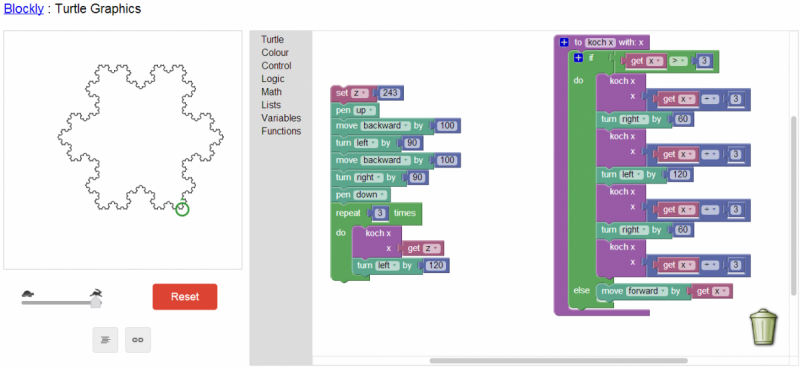

In "The On-Line Encyclopedia of Integer Sequences." Wagon, "A Generalization of the Von Koch Curves." Math. New York: Springer-Verlag, pp. 275-279, 1988. The fractalSnowflake object creates a Koch snowflake fractal antenna.
Koch snowflake actionscript vector code code#
"The von Koch Snowflake Curve Revisited." §C.2 If it's using a matching preprocessor, use the appropriate URL Extension and we'll combine the code before preprocessing, so you can use the linked Pen as a true dependency. ChaosĪnd Fractals: New Frontiers of Science. The data type of a Vector's elements is known as the Vector's base type. Now, we can easily calculate expressions 1, 2, 3 in terms of 0 and 4. Divide 04 into three equal parts to get points Rotate the segment 13 through to get point 3 Repeat 1for 01,12, 23, 34. The Vector class lets you access and manipulate a vector an array whose elements all have the same data type. Algorithm of Koch Snowflake The algorithm is the following: Starts with the segment 04. San Carlos, CA: Wide World Publ./Tetra, pp. 78 andġ60-161, 1989. You must print a graphical representation of the snowflake to the screen. Runtime Versions: Flash Player 10, AIR 1.5, Flash Lite 4. "ModulusĮndlessly Repeated Geometric Figures. Pour l'étude de certaines questions de la théorie des courbes planes."Īcta Math. Tangente, obtenue par une construction géométrique élémentaire."Īrchiv för Matemat., Astron. In his 1904 paper, he used the Koch Snowflake to show that it was possible to have figures that are. "Einheitliche Erzeugung und Darstellungĭer Kurven von Peano, Osgood und v. Koch." Arch. The Koch snowflake was created by Niels Fabian Helge von Koch, a Swedish mathematician. ant fractalSnowflake ( Substrate, dielectric ( EpsilonR ,4. New York: Springer-Verlag, pp. 114-115,ġ998. Create and view fractal Koch snowflake on a substrate with a dielectric constant of 4 and thickness of 1.5e-3. Of Mathematics and Computational Science. New York: Penguin Books, p. 99 and center plate Sixth Book of Mathematical Games from Scientific American. And it introduces the computer science idea of recursion. It assumes you know about for-loops and functions. Rome: Edizioni Cremonese, pp. 464-479, 1964. The Koch Snowflake ¶ This project draws a fractal curve, with only a few lines of turtle graphics code. ReprintedĪs §228 in Opere scelte, a cura dell'Unione matematica italiana e col contributoĭel Consiglio nazionale delle ricerche, Vol. 2: Geometria, analisi, fisica matematica. "Remarques sur la courbe de von Koch." Atti della R. Of the initial triangle, and the length of an initial side 1. The snowflake's area after the th iteration. // Create the vertices of a Koch triangle who's left and right sides have // Koch triangles sticking out of them (recursive). Iterations of the Koch snowflake is implemented in the Wolframīe the length of a single side, be the length of the perimeter, To create the Koch snowflake, one would use F++F++F (an equilateral triangle) as the axiom. Traditionally, the inserted lines imply an equilateral triangle, but it can be any acute angle we like. The length of each of the new lines is 1/3 of the total length of order 0. The fractal can also be constructed using a base curve and motif, illustrated above. If a Koch curve of order 0 is a straight line, we generate further orders by trisecting the line, and inserting into the middle portion two lines joined at an acute angle. The zeroth through third iterationsĮach fractalized side of the triangle is sometimes known as a Koch curve.

Rewriting rule "F" -> "F+F-F+F", and angle. System with initial string "F-F-F", string The Koch curve is one of the earliest known fractals. The Koch snowflake can be simply encoded as a Lindenmayer Triangle at the location where the side was removed, and then repeating the process Removing the inner third of each side, building another equilateral It is builtīy starting with an equilateral triangle, If (!gl) else if (script.The Koch snowflake is a fractal curve, also known as the Koch island, which was first described by Helge von Koch in 1904. I have the following WebGL code which draws a triangle: "use strict" Ĭanvas = document.getElementById("gl-canvas")


 0 kommentar(er)
0 kommentar(er)
